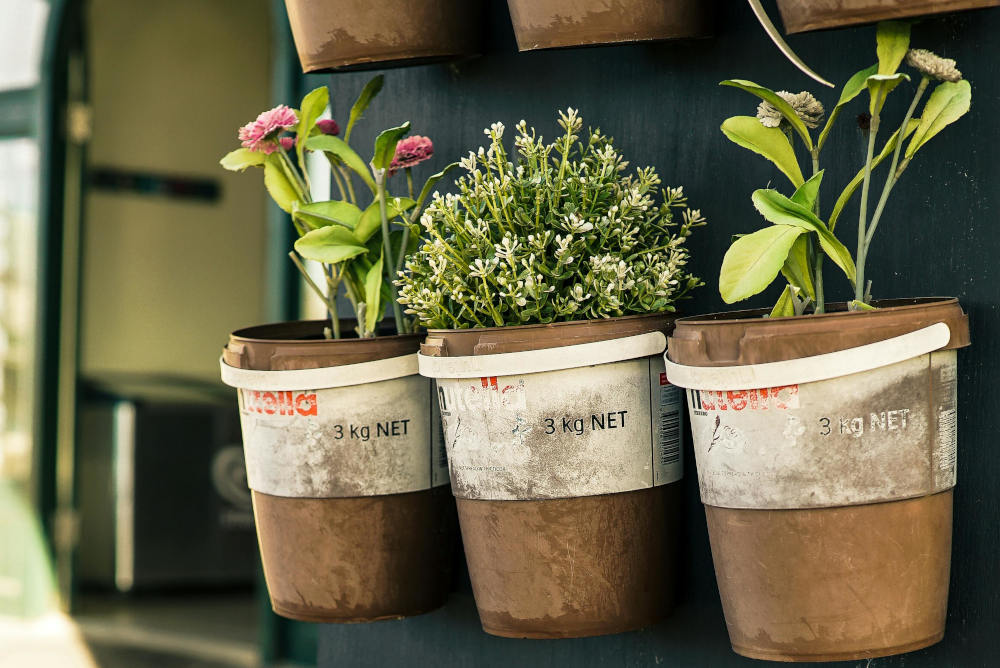
Kräuter in Töpfen zu züchten ist eine lohnende und praktische Möglichkeit, frische Aromen in die Küche und einen duftenden Duft in den Garten zu bringen. Doch wie wäre es, wenn Sie die Gesundheit Ihrer Kräuter fördern, Bestäuber anlocken und gleichzeitig die Optik Ihrer Töpfe verbessern könnten? Hier kommt das Pflanzen von Blumen und Kräutern in denselben Töpfen ins Spiel. Bestimmte Blumen ergänzen Kräuter nicht nur optisch, sondern fördern durch die natürliche Gemeinschaft auch ihr Wachstum.
In diesem Artikel erkunden wir die besten Blumen, die man mit Kräutern in Töpfen pflanzen kann, die Wissenschaft hinter der Mischkultur und wie man erfolgreich gemischte Behälter für einen blühenden und schönen Minigarten einrichtet.
Panaprium ist unabhängig und wird vom Leser unterstützt. Wenn Sie über unseren Link etwas kaufen, erhalten wir möglicherweise eine Provision. Wenn Sie können, unterstützen Sie uns bitte monatlich. Die Einrichtung dauert weniger als eine Minute und Sie werden jeden Monat einen großen Beitrag leisten. Danke schön!
Warum Blumen und Kräuter in Behältern kombinieren?
Bei der Kombination von Blumen und Kräutern geht es nicht nur um Ästhetik. Es gibt auch mehrere praktische Vorteile:
1. Schädlingsbekämpfung
Einige Blumen halten Schädlinge fern, die Kräuter häufig befallen. So sind beispielsweise Ringelblumen dafür bekannt, Blattläuse und Fadenwürmer abzuwehren.
2. Anziehung von Bestäubern
Blumen wie Ringelblumen und Kapuzinerkresse ziehen Bienen und Schmetterlinge an, was die Bestäubung von Kräutern wie Basilikum und Thymian verbessert.
3. Verbessertes Wachstum
Bestimmte Blumen-Kräuter-Kombinationen teilen Nährstoffe gut und können sich gegenseitig im Wachstum unterstützen. Beispielsweise können sich Kräuter mit flachen Wurzeln den Platz mit Blumen mit tieferen Wurzeln teilen.
4. Raumeffizienz
Das gemeinsame Pflanzen von Kräutern und Blumen spart Platz – ideal für Terrassen, Balkone oder kleine Gärten.
5. Schönheit und Duft
Gemischte Töpfe bieten ein Fest für die Sinne und verbinden optische Reize mit dem herrlichen Duft von Kräutern und Blüten.
Die besten Blumen zum Pflanzen mit gängigen Küchenkräutern
🌿 Basilikum + Ringelblume
-
Warum es funktioniert: Ringelblumen vertreiben Weiße Fliegen und Blattläuse, die Basilikum befallen. Die fröhlichen orangefarbenen und gelben Blüten ziehen außerdem Bienen an, die für eine bessere Bestäubung sorgen.
-
Tipps zum Anbau: Beide lieben volle Sonne und gut durchlässigen Boden. Regelmäßig gießen und die Blüten der Ringelblumen entfernen, um die Blüte zu fördern.
🌿 Thymian + Steinkraut
-
Warum es funktioniert: Steinkraut zieht nützliche Insekten wie Schwebfliegen an, die sich von Blattläusen ernähren. Thymian bevorzugt einen trockeneren Boden und Steinkraut verträgt ähnliche Bedingungen.
-
Tipps zum Anbau: Verwenden Sie flache, breite Töpfe. Lassen Sie die Erde zwischen den Wassergaben leicht antrocknen. Beide Pflanzen können über den Rand des Gefäßes hinauswachsen und so einen weichen, kaskadenartigen Look erzeugen.
🌿 Petersilie + Kapuzinerkresse
-
Warum es funktioniert: Kapuzinerkresse wirkt wie eine Fallenpflanze und lockt Schädlinge wie Blattläuse von der Petersilie weg. Ihre leuchtenden Blüten sorgen für Farbe und sind zudem essbar.
-
Tipps zum Anbau: Sorgen Sie für mäßiges Sonnenlicht und halten Sie den Boden konstant feucht. Regelmäßig schneiden, um ein Überfüllen zu vermeiden.
🌿 Oregano + Zinnie
-
Warum es funktioniert: Zinnien ziehen Schmetterlinge und Bienen an und fördern so die Bestäubung. Die ausladende Wuchsform des Oreganos passt gut zur aufrechten Form der Zinnien.
-
Tipps zum Anbau: Volle Sonne und gute Luftzirkulation sind entscheidend. Verwenden Sie einen großen Topf, um das Wachstum beider Pflanzen zu ermöglichen.
🌿 Schnittlauch + Stiefmütterchen
-
Warum es funktioniert: Stiefmütterchen sind Blumen der kühlen Jahreszeit, die im Frühling und Herbst gut gedeihen – in denselben Jahreszeiten, in denen Schnittlauch gedeiht. Stiefmütterchen wehren auch bestimmte Gartenschädlinge ab.
-
Tipps zum Anbau: Halb- bis vollsonnig, regelmäßig gießen. Schnittlauch wächst jedes Jahr nach, während Stiefmütterchen saisonale Schönheit bieten.
🌿 Minze + Petunie
-
Warum es funktioniert: Petunien wehren Kürbiswanzen und Blattläuse ab und vertragen etwas Schatten, wie Minze es bevorzugt. Die Ausbreitungsgewohnheit der Minze profitiert von der Eingrenzung in einen Behälter.
-
Tipps zum Anbau: Verwenden Sie einen tiefen Topf, da Minze invasiv ist. Halten Sie Petunien zurück und düngen Sie sie, um die Blüte zu fördern.
🌿 Rosmarin + Lavendel
-
Warum es funktioniert: Beides sind mediterrane Kräuter, die in trockenen, sonnigen Bedingungen gedeihen. Ihre duftenden Blüten ziehen Bestäuber an und wehren einige Schädlinge ab.
-
Tipps zum Anbau: Verwenden Sie sandigen, gut durchlässigen Boden. Vermeiden Sie Überwässerung. Wählen Sie einen großen Behälter für ausreichend Wurzelraum.
So wählen Sie die richtigen Blumen für Ihre Kräuter
Beachten Sie beim Mischen von Kräutern und Blumen in Töpfen Folgendes:
🌞 Lichtanforderungen
Gruppieren Sie Pflanzen mit ähnlichem Sonnenlichtbedarf. Die meisten Kräuter mögen 6–8 Stunden volle Sonne pro Tag, aber einige (wie Minze oder Petersilie) vertragen auch Halbschatten.
💧 Bewässerungsbedarf
Kombinieren Sie Pflanzen mit ähnlichen Feuchtigkeitsvorlieben. Kombinieren Sie beispielsweise einen dürreliebenden Rosmarin nicht mit wasserhungrigen Stiefmütterchen.
🌱 Wachstumsgewohnheiten
Kombinieren Sie aufrechte Pflanzen mit kriechenden Sorten für einen interessanten optischen Eindruck. Vermeiden Sie die Kombination von aggressiven Pflanzen, die sich gegenseitig bedrängen könnten.
🌸 Blütezeit
Wählen Sie Blumen mit gestaffelten Blütezeiten, damit die Töpfe die ganze Saison über gut aussehen. Frühblüher wie Stiefmütterchen können bei wärmerem Wetter durch Zinnien oder Ringelblumen ersetzt werden.
Tipps zum erfolgreichen Eintopfen
1. Verwenden Sie hochwertige Blumenerde
Wählen Sie eine gut durchlässige Blumenerde. Kräuter bevorzugen oft leicht kiesige Erde, insbesondere mediterrane Sorten wie Oregano oder Rosmarin.
2. Wählen Sie die richtige Topfgröße
Große Behälter (Durchmesser: 30 cm+) eignen sich besser für gemischte Bepflanzungen. Sie speichern die Feuchtigkeit besser und bieten den Wurzeln mehr Platz.
3. Drainage hinzufügen
Stellen Sie sicher, dass die Töpfe Drainagelöcher haben. Um Wurzelfäule vorzubeugen, können Sie Kies oder kleine Steine in den Boden geben.
4. Leicht düngen
Die meisten Kräuter mögen keinen zu nährstoffreichen Boden. Verwenden Sie sparsam einen ausgewogenen organischen Dünger, um sowohl Kräuter als auch Blumen zu unterstützen.
5. Regelmäßig beschneiden
Das Beschneiden von Kräutern fördert buschiges Wachstum und verhindert, dass Blüten überhandnehmen. Entfernen Sie verblühte Blüten von blühenden Pflanzen, damit sie frisch aussehen.
Die Wissenschaft der Mischkultur
Mischkultur basiert auf der Idee, dass sich bestimmte Pflanzen gegenseitig beim Wachsen unterstützen. Dieses Konzept hat uralte Wurzeln und wurde bereits von Indianerstämmen und in traditionellen europäischen Gärten verwendet.
Zum Beispiel:
-
Ringelblumen geben eine natürliche Chemikalie in den Boden ab, die schädliche Nematoden unterdrückt.
-
Steinkraut zieht räuberische Insekten an, die Gartenschädlinge fressen.
-
Kapuzinerkresse fungiert als Opferpflanze und lockt Blattläuse von anfälligeren Pflanzen weg.
In Töpfen werden diese Beziehungen aufgrund der Nähe verstärkt. Sie müssen sie jedoch auch genau überwachen, da schlechte Paarungen schnell überfüllt oder gestresst werden können.
Beste Topfkombinationen (nach Thema)
🍽️ Kulinarischer Topf
-
Pflanzen: Basilikum, Schnittlauch, Oregano + Ringelblume oder Kapuzinerkresse
-
Zweck: Erntefreundliche Kräuter mit Schädlingsbekämpfung und Farbe
🐝 Bestäubertopf
-
Pflanzen: Lavendel, Thymian, Salbei + Zinnie oder Steinkraut
-
Zweck: Anlocken von Bienen, Schmetterlingen und Schwebfliegen zur Bestäubung
🧘♀️ Aromatherapie-Topf
-
Pflanzen: Minze, Rosmarin, Lavendel + Ringelblume
-
Zweck: Genießen Sie Duft und optische Harmonie auf Ihrem Balkon oder Fensterbrett
🌿 Pflegeleichter Topf
-
Pflanzen: Rosmarin, Oregano + Petunie oder Steinkraut
-
Zweck: Für vielbeschäftigte Gärtner, die robuste, dürretolerante Schönheit wünschen
Blumen, die nicht zusammen mit Kräutern gepflanzt werden sollten
Nicht alle Blumen sind ideale Begleiter für Kräuter. Bei folgenden Blumen ist Vorsicht geboten:
-
Sonnenblumen: Können Kräuter überschatten und Nährstoffe verbrauchen.
-
Dahlien: Benötigen reichhaltigen Boden und viel Wasser, nicht ideal für mediterrane Kräuter.
-
Geranien (duftende Arten): Können mit Kräutern um Platz und Nährstoffe konkurrieren und ihr Duft kann Küchenkräuter überdecken.
Abschließende Gedanken
Die Kombination von Kräutern und Blumen in Töpfen ist mehr als nur ein platzsparender Trick – es ist eine Möglichkeit, kleine Ökosysteme zu schaffen, die produktiv, schön und naturfreundlich sind. Wenn Sie verstehen, welche Blumen welchen Kräutern gut tun und ihnen die richtigen Bedingungen für ein gemeinsames Gedeihen bieten, werden Sie mit üppigen Gefäßen belohnt, die toll aussehen und viel leisten.
Egal, ob Sie auf einer sonnigen Veranda, einem Fensterbrett oder einer kleinen Terrasse anbauen, versuchen Sie, Kräuter mit passenden Blumen zu mischen und zu kombinieren, um das Beste aus beiden Welten zu genießen – Duft und Geschmack, Farbe und Gesundheit.
Kurzübersicht: Blumen und ihre Kräuterbegleiter
| Blume | Beste Kräuterkombinationen | Vorteile |
|---|---|---|
| Ringelblume | Basilikum, Oregano | Vertreibt Blattläuse und zieht Bestäuber an |
| Steinkraut | Thymian, Salbei | Zieht Schwebfliegen an, leicht zu züchten |
| Kapuzinerkresse | Petersilie, Schnittlauch | Fangpflanze, essbare Blüten |
| Zinnie | Oregano, Rosmarin | Zieht Schmetterlinge und Bienen an |
| Stiefmütterchen | Schnittlauch, Petersilie | Farbe für die kühle Jahreszeit, Schädlingsabwehr |
| Petunie | Minze, Oregano | Hält Kürbiswanzen fern und sorgt für Farbe |
| Lavendel | Rosmarin, Thymian | Duftend, bestäuberfreundlich |
War dieser Artikel hilfreich für Sie? Bitte teilen Sie uns in den Kommentaren unten mit, was Ihnen gefallen oder nicht gefallen hat.
About the Author: Alex Assoune
Wogegen Wir Kämpfen
Weltweit-Konzerne produzieren in den ärmsten Ländern im Übermaß billige Produkte.
Fabriken mit Sweatshop-ähnlichen Bedingungen, die die Arbeiter unterbezahlt.
Medienkonglomerate, die unethische, nicht nachhaltige Produkte bewerben.
Schlechte Akteure fördern durch unbewusstes Verhalten den übermäßigen Konsum.
- - - -
Zum Glück haben wir unsere Unterstützer, darunter auch Sie.
Panaprium wird von Lesern wie Ihnen finanziert, die sich unserer Mission anschließen möchten, die Welt völlig umweltfreundlich zu gestalten.
Wenn Sie können, unterstützen Sie uns bitte monatlich. Die Einrichtung dauert weniger als eine Minute und Sie werden jeden Monat einen großen Beitrag leisten. Danke schön.































0 Kommentare